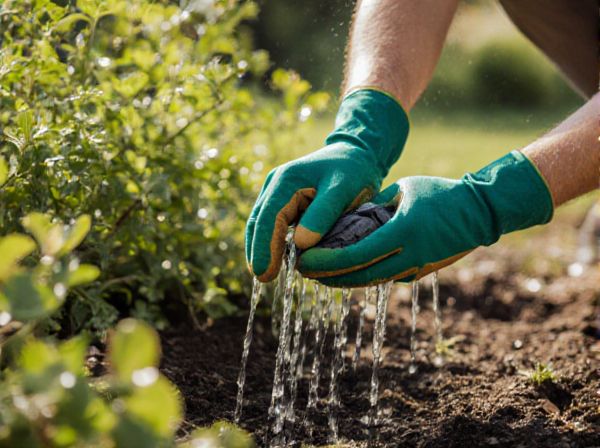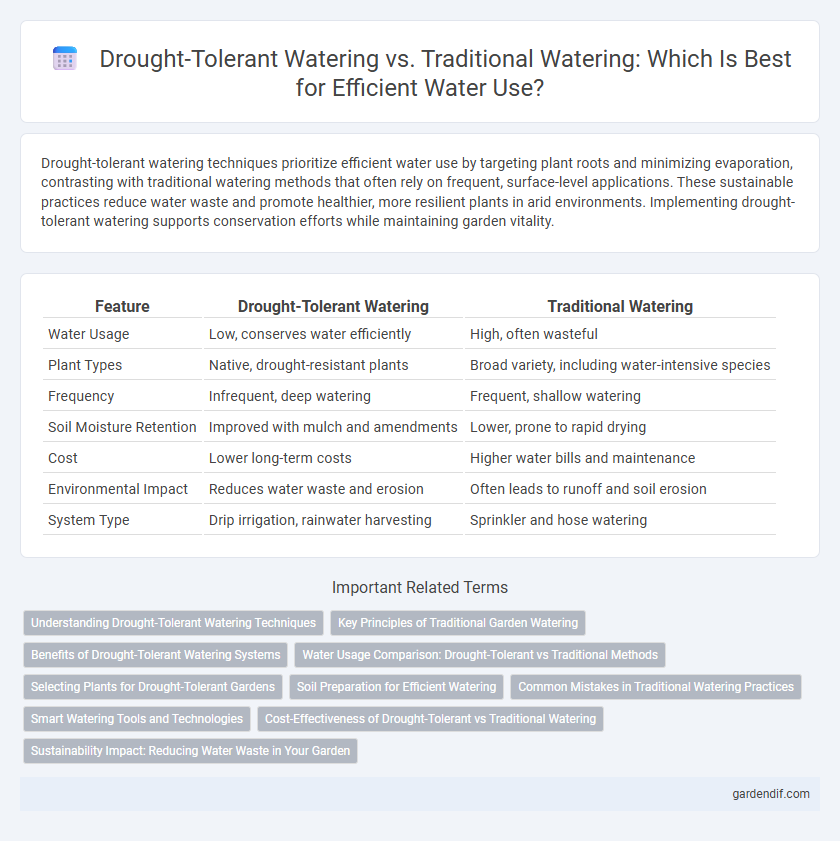
Drought-tolerant watering vs Traditional watering Illustration
Drought-tolerant watering techniques prioritize efficient water use by targeting plant roots and minimizing evaporation, contrasting with traditional watering methods that often rely on frequent, surface-level applications. These sustainable practices reduce water waste and promote healthier, more resilient plants in arid environments. Implementing drought-tolerant watering supports conservation efforts while maintaining garden vitality.
Table of Comparison
| Feature | Drought-Tolerant Watering | Traditional Watering |
|---|---|---|
| Water Usage | Low, conserves water efficiently | High, often wasteful |
| Plant Types | Native, drought-resistant plants | Broad variety, including water-intensive species |
| Frequency | Infrequent, deep watering | Frequent, shallow watering |
| Soil Moisture Retention | Improved with mulch and amendments | Lower, prone to rapid drying |
| Cost | Lower long-term costs | Higher water bills and maintenance |
| Environmental Impact | Reduces water waste and erosion | Often leads to runoff and soil erosion |
| System Type | Drip irrigation, rainwater harvesting | Sprinkler and hose watering |
Understanding Drought-Tolerant Watering Techniques
Drought-tolerant watering techniques emphasize conserving water by using precise irrigation methods such as drip systems and deep root watering that reduce evaporation and runoff. These methods focus on the specific hydration needs of drought-resistant plants, enabling healthier growth with significantly less water compared to traditional overhead sprinklers. Implementing soil moisture sensors and mulching further enhances efficiency by maintaining optimal moisture levels and minimizing water waste in arid conditions.
Key Principles of Traditional Garden Watering
Traditional garden watering relies on consistent, scheduled irrigation to maintain soil moisture and plant health, often using sprinklers or hoses to deliver water uniformly. It emphasizes frequent watering sessions to prevent plant stress but may lead to water wastage due to evaporation and runoff. Key principles include watering early in the morning or late in the evening to minimize water loss and ensuring deep soaking to encourage root growth.
Benefits of Drought-Tolerant Watering Systems
Drought-tolerant watering systems significantly reduce water consumption by targeting irrigation to plant-specific needs, promoting resource efficiency and sustainability. These systems enhance soil moisture retention and minimize runoff, leading to healthier plant growth with less water waste. Implementing drought-resistant irrigation methods lowers utility costs and supports environmental conservation by preserving local water supplies during dry periods.
Water Usage Comparison: Drought-Tolerant vs Traditional Methods
Drought-tolerant watering methods significantly reduce water consumption by targeting plant root zones and utilizing slow-release irrigation systems, conserving up to 50% more water compared to traditional watering techniques that often involve overhead sprinklers and scheduled watering regardless of soil moisture. Traditional watering results in higher evaporation and runoff losses, leading to inefficient water use that can exceed 30,000 gallons per acre per week in standard landscapes. Adopting drought-tolerant approaches can optimize water usage, promoting sustainable landscape management and reducing the strain on municipal water supplies.
Selecting Plants for Drought-Tolerant Gardens
Selecting drought-tolerant plants such as succulents, lavender, and native grasses reduces water consumption significantly compared to traditional watering methods that rely heavily on regular irrigation. These plants have deep root systems and physiological adaptations enabling them to thrive with minimal water, making them ideal for sustainable gardens in arid climates. Incorporating species adapted to local rainfall patterns enhances garden resilience while conserving essential water resources.
Soil Preparation for Efficient Watering
Drought-tolerant watering prioritizes deep soil aeration and organic mulch to enhance moisture retention and reduce water runoff, significantly improving water efficiency compared to traditional watering. Traditional watering often results in shallow root systems due to frequent surface watering, whereas drought-tolerant techniques encourage roots to grow deeper, accessing moisture reserves more effectively. Proper soil preparation, including soil texture optimization and the incorporation of water-absorbing amendments, is critical for maximizing the benefits of drought-tolerant watering methods.
Common Mistakes in Traditional Watering Practices
Overwatering and shallow irrigation are common mistakes in traditional watering practices that lead to water wastage and weak root development. Neglecting soil moisture levels often results in watering either too frequently or insufficiently, promoting plant stress and disease susceptibility. Using fixed schedules rather than adjusting for weather conditions reduces irrigation efficiency compared to drought-tolerant watering techniques.
Smart Watering Tools and Technologies
Smart watering tools such as soil moisture sensors and automated drip irrigation systems optimize drought-tolerant watering by delivering precise water amounts tailored to plant needs, significantly reducing water waste compared to traditional watering methods. These technologies use real-time data and weather forecasts to adjust irrigation schedules, enhancing water efficiency and maintaining healthy landscapes during prolonged dry periods. Integrating smart controllers and remote monitoring platforms improves water conservation efforts while sustaining plant vitality better than conventional sprinkler-based watering systems.
Cost-Effectiveness of Drought-Tolerant vs Traditional Watering
Drought-tolerant watering significantly reduces water consumption by up to 50-70%, lowering utility bills compared to traditional watering methods that often lead to overuse and wastage. Initial installation of drought-tolerant systems, including drip irrigation and mulching, may have higher upfront costs but offer long-term savings through decreased water and maintenance expenses. Over time, adopting drought-tolerant watering proves more cost-effective by enhancing resource efficiency and minimizing environmental impact.
Sustainability Impact: Reducing Water Waste in Your Garden
Drought-tolerant watering methods significantly reduce water waste by targeting plant root zones and using drip irrigation or soaker hoses, promoting efficient water absorption. Traditional watering often involves overhead sprinklers that can lead to evaporation loss and runoff, wasting valuable water resources. Implementing drought-tolerant techniques supports sustainable gardening by conserving water, reducing strain on local water supplies, and maintaining healthier plants during dry periods.
Drought-tolerant watering vs Traditional watering Infographic

 gardendif.com
gardendif.com